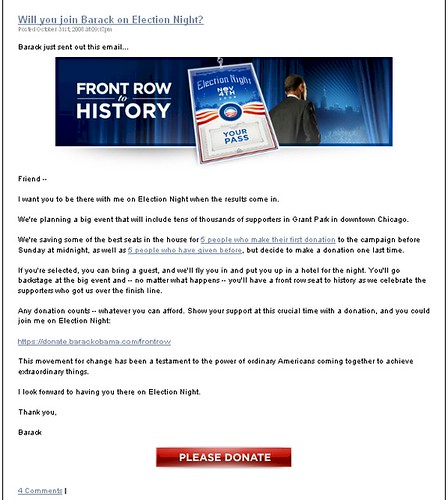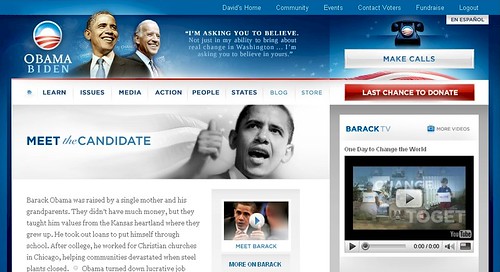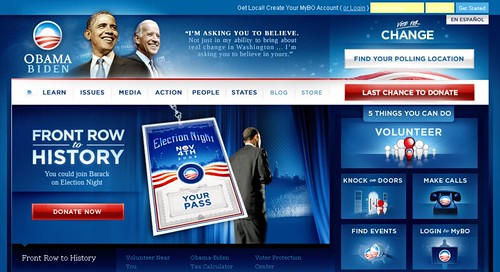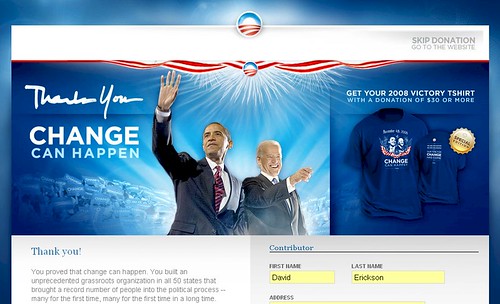Howard Dean‘s 2004 Democratic primary candidacy pioneered online fundraising by proving it could work and provided a sort of proof of concept for using online social networking tools through Meetup.
Barack Obama perfected online fundraising by combining it with social networking and throwing in a dash of the subscription model used by such software-as-a-service companies as SalesForce.com. The end results was a practically self-perpetuating and self-funding money machine. According to The Atlantic, in February 2008 alone, the Obama campaign raised $55 million dollars, $45 million of it online. And the candidate hosted not one fundraiser.
Old School Social Networking
Political campaigning is nothing if not social networking. Politicians spend years building a network of friends, supporters, and very important people whom they can tap once they decide to run for office. But in the practice of old school politics (and everything pre-Obama is old school), those networks were relatively exclusive, reserved for dedicated activists, party stalwarts, talented political insiders, campaign operatives, and the wealthy and well-connected.
Traditionally, you tapped those networks through fundraising events hosted at a home or some other venue, served food, heard from the candidate, and wealthy people would write big checks or well-connected people would bundle checks.
Such an environment is intimidating to say the least for a novice or even for a politically-active person of modest means. And such events are incredibly inefficient and costly for political campaigns.
New School Social Networking
Obama’s use of online social networks opened up that political process to anyone who cared to join, made it easy to participate, and by doing so, created a fundraising machine that could practically print money. And the essential ingredient to this cash cow is micropayments.
Microgiving
The Obama campaign made it incredibly easy to contribute to the cause by allowing supporters to donate small amounts, $20 or even less, and also gave people the option of making these payments recurring. You could contribute $200 a month, which is much easier to do–and budget for–than writing a $2,300 lump sum payment, the maximum allowable individual contribution. By doing so, over time, the campaign can turn small donors into maxed out donors.
According to the Minnesota Independent, 49% of Obama’s supporters’ initially donated less than $200 but by the end of that campaign cycle (October 15, 2008), 27% had contributed up to $999 and 47% had given at least $1000. By lowering the barrier to entry, Obama attracted 100,000 more donors that all of the 2004 candidates combined.
Even if those single $25 contributions didn’t amount to much (but they did), the person who gives you twenty-five bucks may not end up voting for you but he isn’t voting for the other candidate.
Multichannel Appeals
The Obama campaign was not shy about asking for money, they made it easy to contribute by placing the Donate button everywhere they could. They placed it within Google Ads. They placed it on their social networking profiles, like MySpace:
Or in blog posts at BlackPlanet:
They placed it relentlessly in their email updates:
And they still do:
Through their multichannel marketing approach, they created as many opportunities as possible for people to contribute.
Web Site Design
As I mentioned in my previous post, the campaign Web site itself was created so that the donation button was the most eye-catching element of the design. The red Donate button was ever present on the upper right-hand side of nearly every page of the site:
The single page with the largest volume of traffic to most sites is the home page. This is especially true for candidate sites, where there is a lot of offline activity–print and broadcast media, candidate events, etc.–that drives traffic. As such, it is the most valuable real estate of any site. The Obama campaign capitalized on this traffic by putting the fundraising appeal on their Web site front and center, on the front page:
And they still do:
Donation Process
If you’ve previously registered with the site, it pre-populates everything it knows about you in the donation form, so you don’t have to fill out your name, address, zip code and phone number. During the campaign, the donation form was accompanied to the left by a short video of Obama telling you how important your support was to him. Just another nudge, if you needed one, to complete the transaction.
The donation form itself was well-designed. Labels to the form fields were placed on top of, rather than to the side of, the field so that the eye can take in all the information at once, rather than having to dart from label to field. The form required only the information necessary to complete the donation, no more.
The donation process was focused on doing only that task. All distractions from that were removed. Thus, there were no navigation elements on the donation page so you could not go away from the page.
The submit button was clear and obvious.
The whole process was designed to make it as easy as possible to donate by removing any friction or distraction.
Fundraising Army
Finally, the campaign empowered their supporters to do fundraising all on their own, creating built-in incentives to encourage them to achieve their fundraising goals. By offering these tools through their Web site, the campaign vastly expanded its money network by tapping into the networks of their supporters in the most effective way possible, peer-to-peer. You’re far more likely to give money to a candidate that your friends and peer publicly support than you would be to an appeal coming from the campaign itself.
This is a demonstration of the personal fundraising tools the campaign offered supporters through My.Bo:
The irony of this that the candidate who created this machine refused the public funding intended to help level the playing field for campaign money and ran against a chief architect of the McCain-Feingold act, a law devised to help clean up money in politics.
But by introducing a record amount of money from a record amount of people, Obama may be the first President-Elect in the modern era who owes no debt to any specific contributors.
Read also:
The e-Strategy Academy covers all aspects of digital marketing including search optimization & marketing, email marketing, social media marketing, video marketing, mobile marketing & public relations.






